再发一个WF的例子演示
DelayActivity,ListenActivity,CallExternalMethodActivity,HandleExternalEventActivity实现申请,审批,超时否决的演示
使用Winform作为客户端
使用WCF作为客户端与服务器的通信方式
代码很短,很适合正在学习WF,并想快速将WF应用到商业开发的人
例子是在Windwos server 2008 ,VS2008 ,NET3.5下写的
下载 https://files.cnblogs.com/foundation/wxwinter3.rar
应用场景说明:
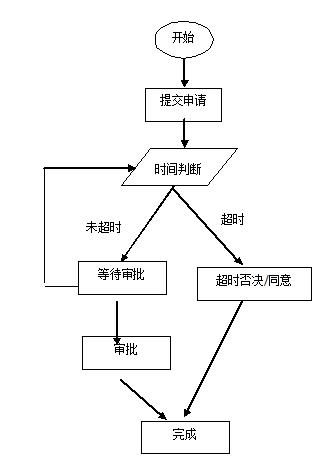
流程设计

使用说明
1.启动引擎服务
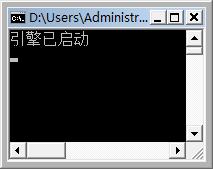
2.客户端提交申请
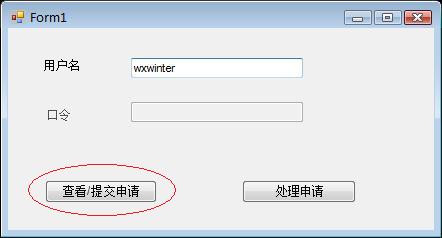

3.审批者登录
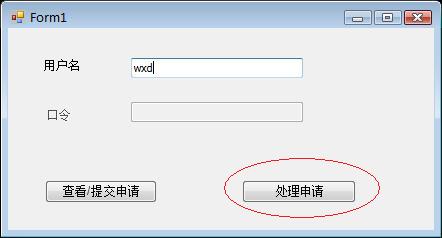
4.审批者审批
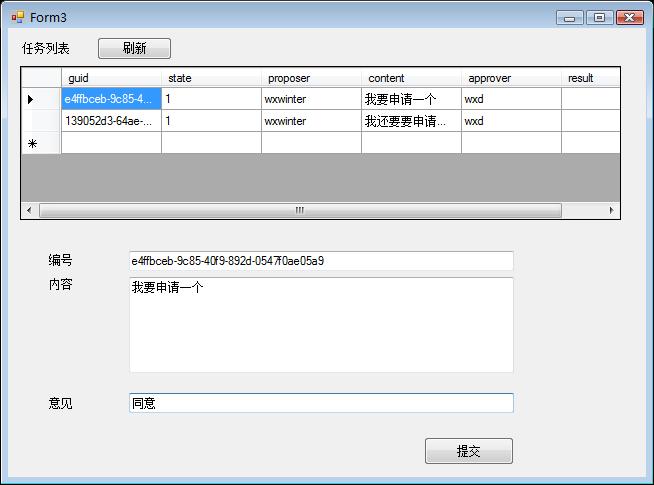
5.申请者查看审批结果
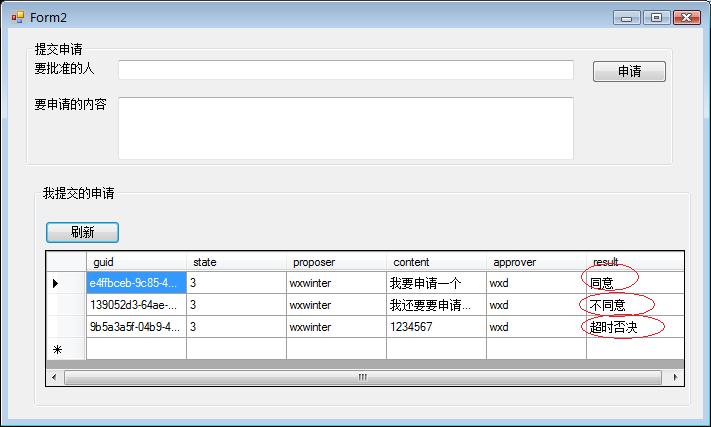
引擎服务的全部代码
 namespace WorkflowConsoleApplication2
namespace WorkflowConsoleApplication2 {
{ class Program
class Program {
{ static void Main(string[] args)
static void Main(string[] args) {
{ DataSet1 ds = new DataSet1();
DataSet1 ds = new DataSet1(); WorkflowRuntime workflowRuntime = new WorkflowRuntime();
WorkflowRuntime workflowRuntime = new WorkflowRuntime(); ExternalDataExchangeService exchange = new ExternalDataExchangeService();
ExternalDataExchangeService exchange = new ExternalDataExchangeService(); workflowRuntime.AddService(exchange);
workflowRuntime.AddService(exchange); exchangeEvent obj = new exchangeEvent(ds);
exchangeEvent obj = new exchangeEvent(ds); exchange.AddService(obj);
exchange.AddService(obj); control ctrl = new control(workflowRuntime, obj);
control ctrl = new control(workflowRuntime, obj); string WCFurl = "http://localhost:567/wxwinter/";
string WCFurl = "http://localhost:567/wxwinter/"; ServiceHost host = new ServiceHost(ctrl, new Uri(WCFurl));
ServiceHost host = new ServiceHost(ctrl, new Uri(WCFurl)); string WCFClassName = "wxdTest";
string WCFClassName = "wxdTest";  host.AddServiceEndpoint(typeof(Icontrol), new BasicHttpBinding(), WCFClassName);
host.AddServiceEndpoint(typeof(Icontrol), new BasicHttpBinding(), WCFClassName); host.Open();
host.Open(); Console.WriteLine("引擎已启动");
Console.WriteLine("引擎已启动"); Console.Read();
Console.Read(); }
} }
}
 class exchangeEvent : IExternalEvent
class exchangeEvent : IExternalEvent {
{ DataSet1 ds;
DataSet1 ds; public exchangeEvent(DataSet1 v)
public exchangeEvent(DataSet1 v) {ds = v;}
{ds = v;} public event EventHandler<NextStepEventArgs> ApproveEvent;
public event EventHandler<NextStepEventArgs> ApproveEvent;
 public void Approve(string gid, string userResult)
public void Approve(string gid, string userResult) {
{ Guid guid = new Guid(gid);
Guid guid = new Guid(gid); NextStepEventArgs e = new NextStepEventArgs(guid);
NextStepEventArgs e = new NextStepEventArgs(guid); e.result = userResult;
e.result = userResult; ApproveEvent(null, e);
ApproveEvent(null, e);
 }
}
 public System.Data.DataSet GetApproverTask(string username)
public System.Data.DataSet GetApproverTask(string username) {
{ System.Data.DataView dv = new System.Data.DataView(ds.infoTab);
System.Data.DataView dv = new System.Data.DataView(ds.infoTab); dv.RowFilter = string.Format("[approver]='{0}' and [state] = 1", username);
dv.RowFilter = string.Format("[approver]='{0}' and [state] = 1", username); System.Data.DataSet temp = new System.Data.DataSet();
System.Data.DataSet temp = new System.Data.DataSet(); temp.Tables.Add(dv.ToTable());
temp.Tables.Add(dv.ToTable()); return temp;
return temp;
 }
}
 public System.Data.DataSet GetProposerTask(string username)
public System.Data.DataSet GetProposerTask(string username) {
{ System.Data.DataView dv = new System.Data.DataView(ds.infoTab);
System.Data.DataView dv = new System.Data.DataView(ds.infoTab); dv.RowFilter = string.Format("[proposer]='{0}'", username);
dv.RowFilter = string.Format("[proposer]='{0}'", username); System.Data.DataSet temp = new System.Data.DataSet();
System.Data.DataSet temp = new System.Data.DataSet(); temp.Tables.Add(dv.ToTable());
temp.Tables.Add(dv.ToTable()); return temp;
return temp; }
}
 public void Notify(dataform df)
public void Notify(dataform df) {
{ System.Data.DataView dv = new System.Data.DataView(ds.infoTab);
System.Data.DataView dv = new System.Data.DataView(ds.infoTab); dv.RowFilter = string.Format("[guid]='{0}'", df.guid);
dv.RowFilter = string.Format("[guid]='{0}'", df.guid); switch (df.state)
switch (df.state) {
{ case 1:
case 1:  DataSet1.infoTabRow r = ds.infoTab.NewinfoTabRow();
DataSet1.infoTabRow r = ds.infoTab.NewinfoTabRow(); r.guid = df.guid;
r.guid = df.guid; r.approver = df.approver;
r.approver = df.approver; r.content = df.content;
r.content = df.content; r.proposer = df.proposer;
r.proposer = df.proposer; r.result = df.result;
r.result = df.result; r.state = df.state;
r.state = df.state; ds.infoTab.Rows.Add(r);
ds.infoTab.Rows.Add(r); break;
break; case 2:
case 2:
 ((DataSet1.infoTabRow)dv[0].Row).state = df.state;
((DataSet1.infoTabRow)dv[0].Row).state = df.state; ((DataSet1.infoTabRow)dv[0].Row).result = df.result;
((DataSet1.infoTabRow)dv[0].Row).result = df.result;
 break;
break; case 3 :
case 3 :
 ((DataSet1.infoTabRow)dv[0].Row).state = df.state;
((DataSet1.infoTabRow)dv[0].Row).state = df.state; break ;
break ; }
}  }
} }
}
 [ServiceBehavior(InstanceContextMode = InstanceContextMode.Single)]
[ServiceBehavior(InstanceContextMode = InstanceContextMode.Single)] class control : Icontrol
class control : Icontrol {
{ WorkflowRuntime workflowRuntime;
WorkflowRuntime workflowRuntime; exchangeEvent obj;
exchangeEvent obj; public control(WorkflowRuntime r, exchangeEvent o)
public control(WorkflowRuntime r, exchangeEvent o) {
{ workflowRuntime = r;
workflowRuntime = r; obj = o;
obj = o; }
} public void begingWF(string proposer, string approver, string content)
public void begingWF(string proposer, string approver, string content) {
{ Dictionary<string, object> dc = new Dictionary<string, object>();
Dictionary<string, object> dc = new Dictionary<string, object>(); dataform df = new dataform();
dataform df = new dataform(); df.approver = approver;
df.approver = approver; df.content = content;
df.content = content; df.proposer = proposer;
df.proposer = proposer; df.result = "";
df.result = ""; dc.Add("DF", df);
dc.Add("DF", df); WorkflowInstance instance = workflowRuntime.CreateWorkflow(typeof(Workflow1), dc);
WorkflowInstance instance = workflowRuntime.CreateWorkflow(typeof(Workflow1), dc); instance.Start();
instance.Start(); }
}
 public void Approve(string guid, string result)
public void Approve(string guid, string result) {obj.Approve(guid, result);}
{obj.Approve(guid, result);}
 public System.Data.DataSet GetApproverTask(string username)
public System.Data.DataSet GetApproverTask(string username) { return obj.GetApproverTask(username);}
{ return obj.GetApproverTask(username);}
 public System.Data.DataSet GetProposerTask(string username)
public System.Data.DataSet GetProposerTask(string username) { return obj.GetProposerTask(username);}
{ return obj.GetProposerTask(username);} }
}
 [ServiceContract]
[ServiceContract] public interface Icontrol
public interface Icontrol {
{ [OperationContract]
[OperationContract] void Approve(string guid, string result);
void Approve(string guid, string result); [OperationContract]
[OperationContract] void begingWF(string proposer, string approver, string content);
void begingWF(string proposer, string approver, string content); [OperationContract]
[OperationContract] System.Data.DataSet GetApproverTask(string username);
System.Data.DataSet GetApproverTask(string username); [OperationContract]
[OperationContract] System.Data.DataSet GetProposerTask(string username);
System.Data.DataSet GetProposerTask(string username); }
} }
}
补充一点,对于流程结节的控制,我更喜欢用规则实现,具体见
规则引擎 http://www.cnblogs.com/foundation/archive/2007/08/18/860911.html
这个例子







【推荐】国内首个AI IDE,深度理解中文开发场景,立即下载体验Trae
【推荐】编程新体验,更懂你的AI,立即体验豆包MarsCode编程助手
【推荐】抖音旗下AI助手豆包,你的智能百科全书,全免费不限次数
【推荐】轻量又高性能的 SSH 工具 IShell:AI 加持,快人一步
· 从 HTTP 原因短语缺失研究 HTTP/2 和 HTTP/3 的设计差异
· AI与.NET技术实操系列:向量存储与相似性搜索在 .NET 中的实现
· 基于Microsoft.Extensions.AI核心库实现RAG应用
· Linux系列:如何用heaptrack跟踪.NET程序的非托管内存泄露
· 开发者必知的日志记录最佳实践
· TypeScript + Deepseek 打造卜卦网站:技术与玄学的结合
· Manus的开源复刻OpenManus初探
· 写一个简单的SQL生成工具
· AI 智能体引爆开源社区「GitHub 热点速览」
· C#/.NET/.NET Core技术前沿周刊 | 第 29 期(2025年3.1-3.9)